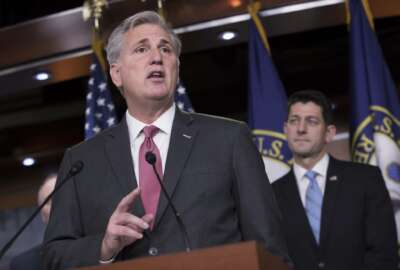
DHS’ Duke: Shutdowns, continuing resolutions ‘very constricting’ to mission
As Congress works to avert a government shutdown before midnight Thursday, the Department of Homeland Security says the perennial cycle of shutdowns and short-t...
Subscribe to Federal Drive’s daily audio interviews on iTunes or PodcastOne.
As Congress works to avert a government shutdown before midnight Thursday, the Department of Homeland Security says the perennial cycle of shutdowns and short-term continuing resolutions has threatened readiness at the agency.
House lawmakers passed another CR bill Tuesday that includes full appropriations for the Defense Department, but would keep current funding levels in place for non-defense agencies until March 23. While military officials have expressed frustration with stop-gap funding, DHS Deputy Secretary Elaine Duke called on senators Wednesday to pass a comprehensive budget for her agency.
“We have to focus on the mission, and because under a CR or a shutdown you’re under last year’s level, it constricts us in adapting to priorities and we can’t do new starts. So if any emerging need comes up, we can’t address it because we can’t start something new. In a mission so dynamic as Homeland Security, that is very constricting,” Duke said before a Senate Homeland Security and Governmental Affairs hearing on reauthorizing the department.
Congress has yet to pass a full budget for FY 2018, even though it’s now in the middle of the second quarter of the fiscal year.
Claire Grady, DHS’ under secretary for management, told lawmakers that the current budget environment has put a “huge burden operationally” on the department.
“In terms of operational planning, in terms of moving out on important hiring efforts, in terms of important acquisitions, we are hamstrung until that gets resolved. And that has a ripple effect throughout, especially when you try and compress spending of very, very important resources for very important capabilities, and then it’s now in a compressed period of time, potentially. It has a huge operational impact, it adds administrative burden and is just difficult to operate, on especially a number of short-term CRs.”
Grady added that back-to-back continuing resolutions have contributed to higher administrative costs at DHS.
“You make short-term decisions to accommodate what you have from a financial perspective that you would not make if you had a full budget available at the beginning of the fiscal year,” he said.
Committee Chairman Ron Johnson (R-Wis.) said he supports the End Government Shutdowns Act, which would provide federal agencies with current-level appropriations to stay open, even if lawmakers don’t meet the deadline to avert a shutdown. The legislation, he added, would eliminate the confusion around back pay for furloughed federal employees and “essential” employees who continue working through a government shutdown.
“The reality of the situation is every time there’s been a government shutdown, everybody gets the back pay. It’s incredibly unfortunate that there’s this level of dysfunction,” Johnson said.
About 70 percent of DHS employees were deemed essential during the last shutdown. Duke said the mere threat of a shutdown can cause unease for agency employees.
“It’s not just the day of the shutdown. It’s the weeks leading up to it, where there’s angst. Some of the biggest portions of our workforce, say, transportation security officers, are in the low end of the scale, and so even having to wait for the money could be critical for them,” she said.
McCaskill: $40K CBP recruiting fee ‘outrageously high’
Sen. Claire McCaskill (D-Mo.), the committee’s ranking member, came down hard on DHS leadership at Wednesday’s hearing for awarding a contract aimed at fixing Customs and Border Protection’s hiring and retention problem.
The $300 million indefinite-delivery, indefinite quantity contract awarded last November pays Accenture Federal Services $40,000 for each new recruit it finds — approximately the first year’s salary of these recruits.
“Forty thousand dollars per employee is outrageously high. We are paying $40,000 to hire somebody we’re going to pay $40,000. For folks where I live, for people who think the government’s lost its mind, that would be Exhibit A.”
Grady told McCaskill that despite offering retention incentives and other recruiting tools, CBP still has an annual net loss of 400 border patrol positions every year. This year, she added, the agency’s net loss grew by another 100 positions.
“We needed to do something above and beyond what we were able to do, particularly with the intent to hire an additional 5,000 border patrol agents. We looked at it carefully and said, ‘This is a surge need.’ We still need to continue to push on all of the flexibilities, from an HR perspective. We have to meet our staffing needs. But to meet that surge, we did it [with] assistance over and above what we had, and we awarded a contract to a company who has a proven track record for [the] ability to accomplish just that,” Grady said.
The 5,000 border patrol hiring surge is part of President Donald Trump’s strategy to grow the agency, along with Immigrations and Customs Enforcement.
Part of CBP’s hiring problem has been its lengthy hiring process. Sen. James Lankford (R-Okla.) said the average time to hire at CBP has hovered around 350-to-400 days.
Grady said CBP is working to address the time-to-hire problem, and has also looked at other ways to view the data. She said the agency found the hiring issue to be less acute when it weeded out some cases, such as “an extreme outlier,” where it took more than 800 to fill one job.
By streamlining multiple hiring steps at recruiting events, CBP has also been reducing the pool of applicants it takes to hire one agent
“That number was well into triple digits. We have that now into double digits, which is still way too high,” Grady said.
Copyright © 2024 Federal News Network. All rights reserved. This website is not intended for users located within the European Economic Area.
Jory Heckman is a reporter at Federal News Network covering U.S. Postal Service, IRS, big data and technology issues.
Follow @jheckmanWFED
Related Stories
 Exclusive
Exclusive 



